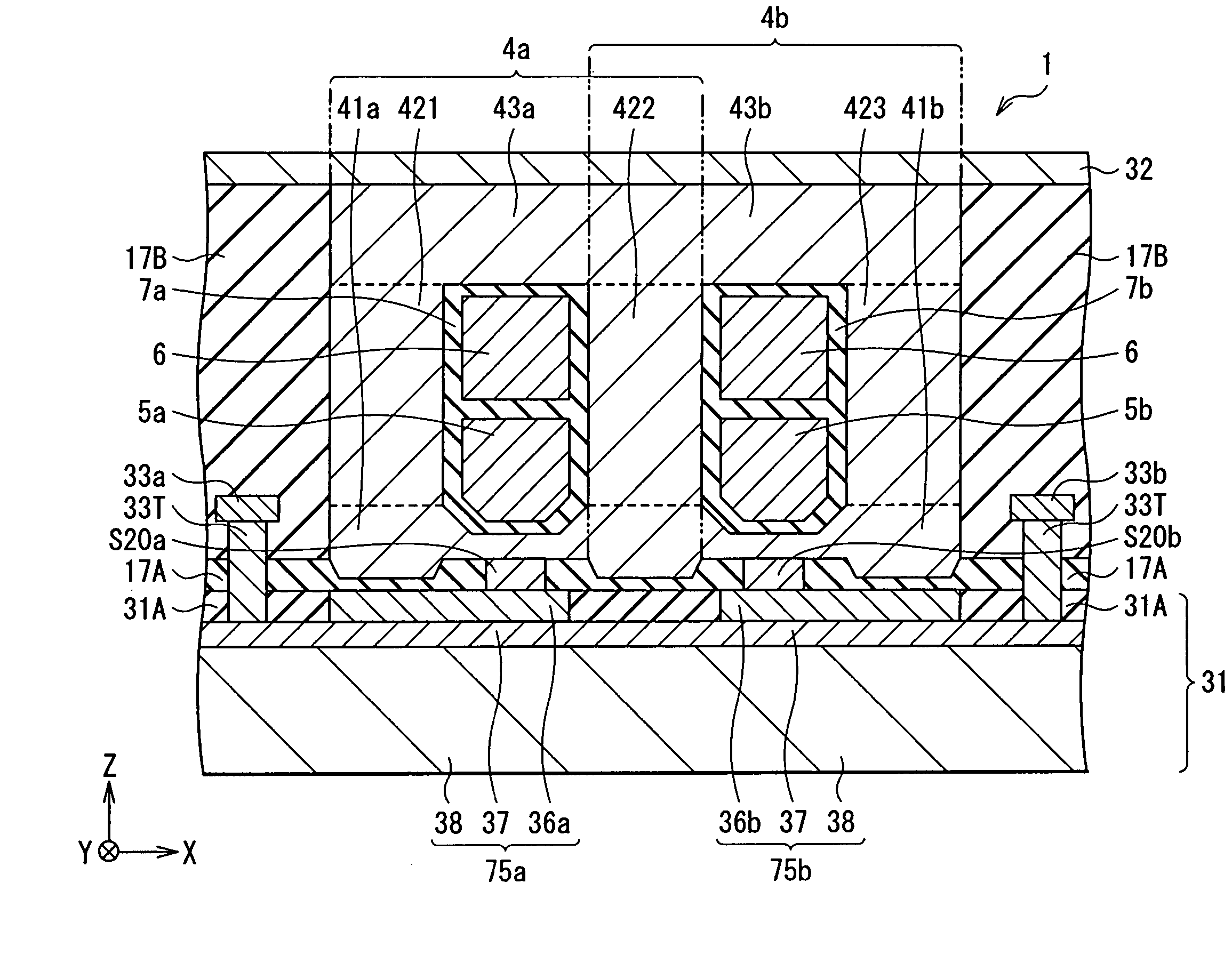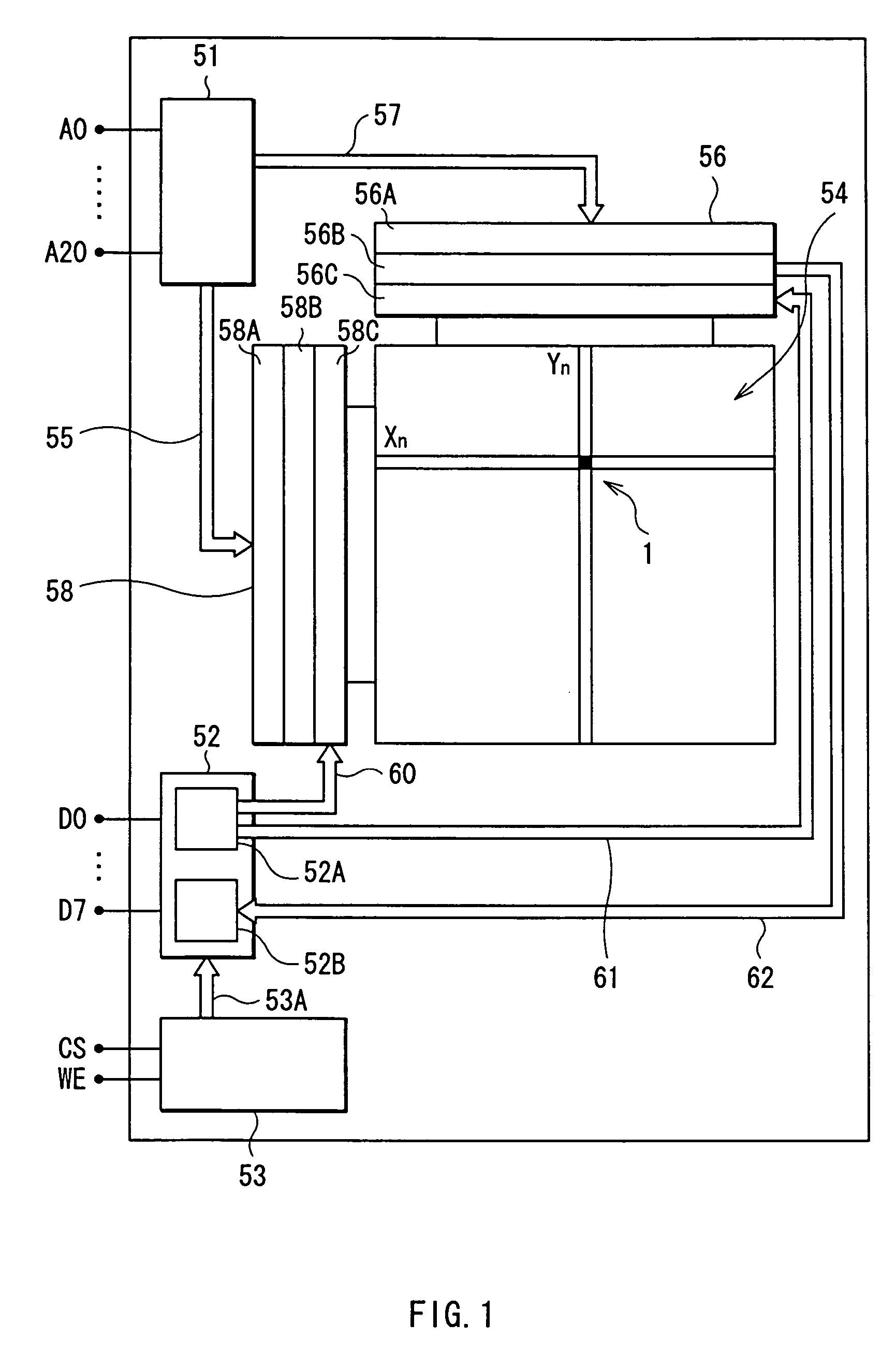Magnetoresistive element, magnetic memory cell, and magnetic memory device
a technology of magnetic memory cell and magnetic memory device, which is applied in the direction of digital storage, semiconductor devices, instruments, etc., can solve the problems of difficult to perform sufficiently stable writing operation, and achieve the effect of stably writing by efficiently using
- Summary
- Abstract
- Description
- Claims
- Application Information
AI Technical Summary
Benefits of technology
Problems solved by technology
Method used
Image
Examples
first modification
[0144]FIGS. 30A and 30B show the configuration of a memory cell 1V1 as a first modification of the embodiment. FIG. 30A shows the configuration of an XY plane parallel to the stacked face of the stacked bodies S20a and S20b. FIG. 30B is a cross section taken along line XXX(B)—XXX(B) of FIG. 30A. As described above, in the embodiment, the first beam yokes 41a and 41b in the magnetic yokes 4a and 4b are constructed so that the width in the extending direction (Y-direction) of the write bit lines 5a and 5b and the write word line 6 becomes the minimum in the connection parts 14a and 14b and the width of the stacking direction (Z direction) of the stacked bodies S20a and S20b in the connection parts 14a and 14b, that is, the thickness becomes the minimum in the connection parts 14a and 14b. In contrast, in the memory cell 1V1 of the modification, the magnetic yoke 4V1 is constructed so that the thickness of the first beam yoke 41 becomes uniform and width W14 in the Y-direction of the c...
second modification
[0145]FIGS. 31A and 31B show the configuration of a memory cell 1V2 as a second modification of the embodiment. FIG. 31A shows the configuration of an XY plane parallel to the stacked face of the stacked bodies S20a and S20b. FIG. 31B is a cross section taken along line XXXI(B)—XXXI(B) of FIG. 31A. In the memory cell 1V1 of the first modification, the thickness of the first beam yoke 41V1 is made uniform and the width in the Y-direction of the connection parts 14a and 14b is made narrower than the adjacent parts. It is also possible to make the width W1 in the Y-direction of a first beam yoke 41V2 uniform and make the thickness T14 of the connection parts 14a and 14b smaller than the adjacent parts. Concretely, the memory cell 1V2 is constructed to have thickness T41 larger than the thickness T14 of the connection parts 14a and 14b only by height T1 by making the first beam yoke 41V2 have the projection 41T projected toward the stacked bodies S20a and S20b only by the height T1.
third modification
[0146]FIGS. 32A and 32B show the configuration of a memory cell 1V3 as a third modification of the embodiment. FIG. 32A shows the configuration of an XY plane parallel to the stacked face of the stacked bodies S20a and S20b. FIG. 32B is a cross section taken along line XXXII(B)—XXXII(B) of FIG. 32A. In the memory cell 1V2 of the second modification, the projection 41T projected toward the stacked bodies S20a and S20b is provided. Alternately, like a memory cell 1V3 shown in FIGS. 32A and 32B, a first beam yoke 41V3 may have inclined faces 41AK on both sides of the connection parts 14a and 14b and the thickness increases to the side opposite to the stacked bodies S20a and S20b in the stacking direction (Z direction) of the stacked bodies S20a and S20b with distance from the connection parts 14a and 14b. Also in the configuration, the thickness T14 of the connection parts 14a and 14b can be made smaller than the thickness T41 of the portion adjacent to the connection parts 14a and 14b...
PUM
 Login to View More
Login to View More Abstract
Description
Claims
Application Information
 Login to View More
Login to View More - R&D
- Intellectual Property
- Life Sciences
- Materials
- Tech Scout
- Unparalleled Data Quality
- Higher Quality Content
- 60% Fewer Hallucinations
Browse by: Latest US Patents, China's latest patents, Technical Efficacy Thesaurus, Application Domain, Technology Topic, Popular Technical Reports.
© 2025 PatSnap. All rights reserved.Legal|Privacy policy|Modern Slavery Act Transparency Statement|Sitemap|About US| Contact US: help@patsnap.com



